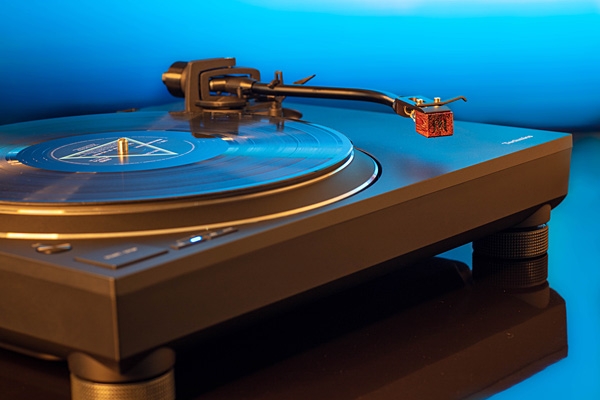
When a reader is unfamiliar with the other components I mention, my exposition becomes abstract—useful entertainment if it’s useful at all. That’s why I believe strongly in comparing products under review to widely known and respected reference components whenever possible.
Fortunately, in the current era of ultra-fi headphones and with the global popularity of CanJams, most audiophiles can experience a wide range of digital sonics without buying anything. If I refer to the dCS Bartók, HoloAudio Spring, or Mytek Manhattan II, most CanJammers (and readers) will at least have had the opportunity to experience the sound these converters make. All are popular, single-box DACs representing a particular manufacturer’s viewpoint.
With phono cartridges, it’s harder. The sound of phono is a mélange of the many vibrating contraptions comprising someone’s curated record-playing system. Each cartridge manufacturer has its own “house sound.” Each model in a manufacturer’s lineup sounds different. What’s more, phono cartridges perform differently with different phono stages, tonearms, tonearm cables, turntables, and even record pressings.
The best any phonophile can do is listen widely: at audio shows, in dealer showrooms, at friends’ homes. In lieu of that, or in addition to it, they can study reviews and scan hi-fi forums. If you are new to analog, start simple and cheap and try a variety of products to learn the ways that moving magnet, moving coil, moving iron, and “optical” cartridges sound different from each other.
In that spirit, my hope for this month’s column is to contribute my “two empirical bits” to the larger consensus on Herbie’s way-effective turntable mat and two sensible-level phono cartridges: Grado’s low-output moving iron Platinum3 ($400) and Goldring’s high-output moving coil Eroica HX ($899).
Herbie’s Way Excellent II Turntable Mat
When I began at Stereophile, I bought a used Technics SL-1200MK2 ($80 at a stoop sale). It came with scratches and a felt slipmat. Then, in GD9, I hot-rodded it by installing a stainless steel SME M2-9 tonearm and Technics’s original-issue, 6mm soft-rubber platter mat (part number: SFTG172-01). With most turntables, I stick with whatever resting surface the manufacturer supplies, but whenever I use a direct-drive ‘table, I have an urge to experiment with platter coverings. I’ve collected a good pile of turntable mats: With the Technics SL-1200 and my Pioneer PLX-1000, I’ve experimented with graphite, felt, three thicknesses of cork, plus various thicknesses of soft and hard rubber. I always come back to soft rubber, which seems to reduce groove noise and improve retrieval of detail.

During my review of Music Hall’s Stealth direct-drive record player, I experimented with a few of the softest mats in my hoard and stumbled on what, to me, feels like a long-term solution: the $88 Way Excellent II Turntable Mat from Herbie’s Audio Lab (footnote 1), which was originally reviewed by Robert Deutsch in February 2016.
As I installed it, I was impressed by this mat’s grip on the surface of the Stealth’s cast platter. I also liked how well this mat supported records, with just the right degree of sponginess to ensure full contact, with no gaps under the record.
Comparing Stealth’s stock mat to the Herbie mat, I observed that the Herbie mat played records with less noise, firmer rhythm, and a sharper but more relaxed focus. The perception of grain or haze in quiet passages was reduced, making images seem more vivid and distinctly outlined, voices in choirs less blended.
Herbie’s Way Excellent II mat has made Music Hall’s Stealth ($1649) my new reference record player for auditioning moderately priced phono cartridges.
Grado Platinum3 Moving Iron
Since I first heard it, I’ve described Grado’s wood-bodied Timbre Series Platinum3 moving iron cartridge—a midprice member of the wood-bodied Timbre series—as a poor man’s Koetsu because in my system, and in a friend’s, it produces lush, spacious, color-saturated sound (footnote 2).

It might be more accurate, though, to describe the low-output Platinum3 as a prudent person’s Aeon, in reference to Grado’s $6000 low-output Lineage Series Aeon3, which I described in GD39, or maybe as a thrift-shop Epoch, referring to Grado’s $12,000 flagship low-output cartridge, the Epoch3, which was reviewed in the May 2020 issue of Stereophile. I’ve compared the Platinum3 to the Aeon3 in my own system on the Dr. Feickert Blackbird turntable with a Thomas Schick tonearm, and I’ve compared it to the Epoch3 in my friend’s system. To my ears, these three cartridges seem like three distinct levels of price and refinement of what I regard as the basic Grado sound, a sound best demonstrated in Grado’s low-output cartridges and best described as darkish, morgue quiet, glass clear, and (bass- and spacewise) big. And fun.
All three low-output Grados are designed to generate 1mV into a 10k–47k ohm load, which means users will need a phono stage that can supply moving coil–level gain (60dB) into a moving magnet– type load (47k ohms). Neither of my tubed phono stages—the Tavish Design Adagio and the SunValley phono equalizer—could do that. Fortunately, Kitsuné HiFi’s KTE LCR-1 MK5 and Parasound’s Halo JC 3+ phono preamplifiers, and Rogue Audio’s Pharaoh II integrated amplifier were available to me. I used all three for this report, but the Rogue’s excellent phono stage got extra time because the Platinum3 made it sound especially radiant and high-class.

As part of Grado’s Timbre Series, which includes the $275 Opus3, $600 Sonata3, $1000 Master3, and $1500 Reference3, the $400 Platinum3 is offered in high (4mV) or low (1mV) output, with a mono version at both output levels. While the Master and Reference cartridges are equipped with boron cantilevers, the Platinum3 uses an aluminum tube, which Grado’s website describes as a modified version of their four-piece OTL cantilever technology. While the $12k Epoch3 uses pure gold wire for its coils, the Platinum3 uses ultrahigh-purity long crystal (UHPLC) oxygen-free copper.
The Platinum3’s wide, heavy (9gm) body is made of Australian jarrah wood, which looks hip and exotic, but its low-slung widebody-ness makes it dang near impossible to see where the stylus tip is, or where it might land as it approaches the record surface. Even cleaning the needle is tricky. I found this constantly disconcerting. John Grado, who designed the Platinum3 and builds them by hand, believes it’s worth it; he says, “The woodbody cartridges track tremendously. We found the balance fore and aft relative to the center of gravity to be a contributing factor for this stability.”
I used the Platinum3 to play scores of records from every genre in my collection. I learned that, unlike the more expensive and controlled-sounding Aeon3, its response felt slightly tipped up at the frequency extremes. The Platinum3 makes big bass, deep space, and lots of sparkle, but that’s because the 2kHz-centered presence region seems recessed. This slight “smiley” response lends a feeling of warmth and soul that lets a record like the Walker Brothers’ 1978 Nite Flights (LP, Music On Vinyl MOVLP 1356) hold my attention through both sides—but it also makes the dynamics hit softer. Playing “Pipeline” on the Ventures album Surfing (LP, Dolton BLP-8022) made me wish for the smack and ping and raunchy-reverb twang I get playing it with the $349 Denon DL-103 moving coil. I tried several similar ’60s recordings, and the Platinum3 did not do raunchy guitar sounds with anything resembling the grungy presence of live. I don’t see the 3 as the ideal 1970s Led Zep and punk-band tracer, but I promise it will make you happy playing 1980s dance, electronica, and indie tunes. It was made to play Yello, Kraftwerk, and Grace Jones.
Footnote 1: See the photos at Herbie’s website.
Footnote 2: Grado Labs, 4614 7th Ave., Brooklyn, NY 11220. Tel: (718) 435-5340. Web: gradolabs.com
- Log in or register to post comments

Needs to be more widely known.

Herb, I agree about the Herbie’s. My favorite thing to look for when evaluating mats is the quality of bass response. Turn up the volume (to exaggerate the differences) and listen to the bass frequeicies. Punchy beats and sustained notes. How is the strength of impact? Definition of notes? Does the midbass fill color the midrange?
The Way Excellent II rose above the others I tried on my turntable in my system with the most well defined bass response and uncolored midrange.

Hi Herb, you write “For many years, I favored cartridges with aluminum cantilevers and forgiving, elliptical styli, but nowadays I get excited by the turbocharged, dynamic performance of unforgiving, uber-detailed, line-contact styli like the Gyger II.” I had to laugh when I read this as I have found my listening preferences have trended in the opposite direction. I have for the last several years been happily listening with a Shelter 501. Now when I hear more detailed cartridges, I am almost invariably fatigued quickly. Funny how that works. Good thing I am not a reviewer, I guess. Thanks for all the great columns.
P.S. E. Power Biggs is a ball and it’s great to see his stuff used in a review. I threw my copy of the same on right after reading the column.

Tavish’s Classic may not be as accomplished as the Adagio, but it pairs well with low output Grados. Mine was set at 53 db gain and 47k load with good results.
Needs to be more widely known.
Herb, I agree about the Herbie’s. My favorite thing to look for when evaluating mats is the quality of bass response. Turn up the volume (to exaggerate the differences) and listen to the bass frequeicies. Punchy beats and sustained notes. How is the strength of impact? Definition of notes? Does the midbass fill color the midrange?
The Way Excellent II rose above the others I tried on my turntable in my system with the most well defined bass response and uncolored midrange.
Hi Herb, you write “For many years, I favored cartridges with aluminum cantilevers and forgiving, elliptical styli, but nowadays I get excited by the turbocharged, dynamic performance of unforgiving, uber-detailed, line-contact styli like the Gyger II.” I had to laugh when I read this as I have found my listening preferences have trended in the opposite direction. I have for the last several years been happily listening with a Shelter 501. Now when I hear more detailed cartridges, I am almost invariably fatigued quickly. Funny how that works. Good thing I am not a reviewer, I guess. Thanks for all the great columns.
P.S. E. Power Biggs is a ball and it’s great to see his stuff used in a review. I threw my copy of the same on right after reading the column.
Tavish’s Classic may not be as accomplished as the Adagio, but it pairs well with low output Grados. Mine was set at 53 db gain and 47k load with good results.







